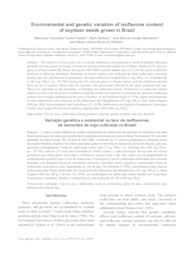Environmental and genetic variation of isoflavone content of soybean seeds grown in Brazil.
Environmental and genetic variation of isoflavone content of soybean seeds grown in Brazil.
Author(s): CARRÃO-PANIZZI, M. C.; BERHOW, M.; MANDARINO, J. M. G.; OLIVEIRA, M. C. N. de
Summary: Abstract The objective of this work was to evaluate isoflavone concentrations in seeds of different Brazilian soybean cultivars grown in a range of locations and environmental conditions in Brazil. Seeds of 233 cultivars grown in Ponta Grossa, PR, Brazil, during the 2001/2002 soybean season, and of 22 cultivars sown in different locations of Brazilian Northeast, Southeast on South regions were analyzed for total isoflavones, including daidzin, glycitin, genistin and acetylgenistin. The total isoflavones ranged from 12 mg 100 g?1 (cv. Embrapa 48) to 461 mg 100 g?1 (cv. CS 305) among the 233 cultivars grown in Ponta Grossa, and the differences among them are due to genetic effects since all cultivars were grown and collected at the same locatation and year. This is an indication of the possibility of breeding for isoflavone content. Differences in isoflavone content observed in the cultivars grown in different locations permit the selection of locations for optimum isoflavone content (low or high), depending on the uses of soybean. In the Northeast region (5–8°S), higher concentrations of total isoflavones were observed at São Raimundo das Mangabeiras (232 mg 100 g?1) and Tasso Fragoso (284 mg 100 g?1) municipalities, and in the South (23–30°S), isoflavones were higher in Guarapuava, Canoinhas, Vacaria and Campos Novos municipalities, ranging from 130 to 409 mg 100 g?1. Index terms: Glycine max, isoflavones, sowing location, soybean grains, soybean cultivars, soyfood.
Publication year: 2009
Types of publication: Journal article
Unit: Embrapa Soybean
Keywords: Alimento, Alimento derivado de soja, Bioquímica, Cultivar de soja, Cultivares de soja, Food and Human Nutrition, Glycine Max, Grão de soja, Grãos de soja, Isoflavona, Isoflavonas, Isoflavonas nas sementes de diferentes cultivares brasileiras de soja, Isoflavones, Local de semeadura, Nutrição humana, Soja, Sowing location, Soybean cultivarars, Soybean cultivars, Soybean grains, Soybeans, Soyfood
Observation
Some of Embrapa's publications are published as ePub files. To read them, use or download one of the following free software options to your computer or mobile device. Android: Google Play Books; IOS: iBooks; Windows and Linux: Calibre.
Access other publications
Access the Agricultural Research Database (BDPA) to consult Embrapa's full library collection and records.
Visit Embrapa Bookstore to purchase books and other publications sold by Embrapa.

